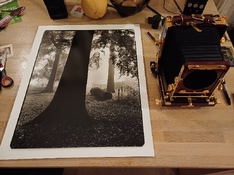A few more tips for if you want to try this method of drying FB paper:
- Keep a kitchen towel at hand to remove excess water running of the print.
- Let the water run down of your print until it trickels.
- Put the paper against the glass - without(!) - applying pressure. Simply let it 'stick' on the still present waterfilm. If you apply pressure, you make it more likely the paper itself will stick to the glass and tear. This won't happen if you do as I write.
- Wait until the waterfilm has receded far enough from the top of the print to safely apply the top tape, all the while using the towel to remove water slowly trickling of the print. This usually takes about 10 minutes.
- Cut the artist's tape and use the plant spray set to disperse fine droplets to wet the tape. Glue side is inside of roll. Distance about one feet, quick run down from top to bottom of the stretch of tape held in your left hand. The tape should NOT be soaked! Only sparse droplets visible on the tape, see photo.
- Put the tape over the top of the print with a 1cm overlap. Do NOT apply pressure to the tape and print!!! Use a very soft caressing gesture to make it stick properly to the print and glass, this is enough! The glue is very sticky when wett, and will hold the print fine when it dries and tension on the paper starts flattening it totally. Putting pressure will enhance the risk of glue getting behind the print or the print by itself sticking to the glass, causing tears.
- If the paper or tape was to wet, water with glue may trickle over the surface of the print. Either use the towel to to collect it if you notice this in time, or start anew by resoaking and quick wash in water to remove the glue.
- After about 20 minutes or so, you can apply the tape to the sides. Use the towel to remove the thin layer of water collected at the bottom 0,5 cm of the print before doing this.
- After about 30 minutes it is usually safe to tape down the lower part, if the waterfilm has receded enough. Again use the towel to remove excess water visible before applying the tape.
- Do NOT wait to long either with applying the tape! Timing is crucial, as an already drying FB print sheet will apply significant force on the tape, and if the glue hasn't had enough time to dry and set, the shrinking paper will rip it loose and the paper will curl.
- If this happens, remove the print and soak it in water. The glue will easily dissolve in water and the remaining tape stuck to the print will float away. You can then start from scratch and try again.
- When the paper has fully dried, you can either try to tear it loose by the end of one of the tape strips. If you've used sparse droplets, the print may simply release easily from the glass. If that doesn't work, simply use a sharp knife to cut it from the glass, being carefull not to damage the print or scratch the glass.
- To clean the glass from remaining tape, simply soak the tape with warm water to dissolve the glue and remove the tape remains. Thoroughly rinse and wash the glass to remove all traces of the glue, or your next batch of prints may get ruined if you put the print over traces of glue. Again, the glue easily dissolves in warm water, so isn't problematic to remove.
I usually put about 4 sheets at a time to the glass, and then work on all of them at the same time, which cuts down on the total time needed.
I have succesfully dried and flattened prints up to 50x60cm using this method.








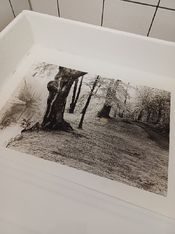

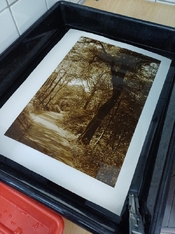
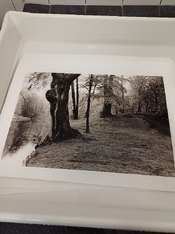




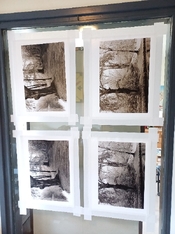

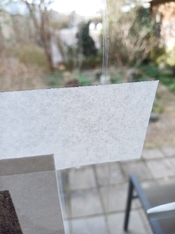

 . Up to 40x50cm I can reasonably manage, but this size required putting the giant washing tray outside the home darkroom.
. Up to 40x50cm I can reasonably manage, but this size required putting the giant washing tray outside the home darkroom.